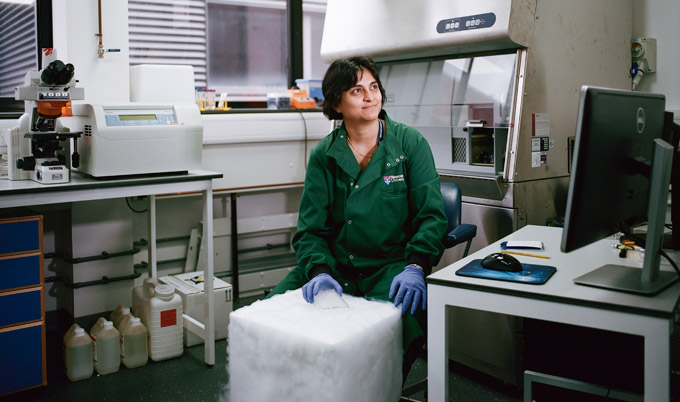Kidney cancer
Kidney cancer's developmental source revealed
Published on: 9 August 2018
In the first experiment of its kind, scientists have revealed the precise identity of cancer cells of the most common childhood and adult kidney cancers.
Researchers from Newcastle University, the Wellcome Sanger Institute, University of Cambridge, and collaborators, showed that the cancer cells are versions of specific healthy cells from developing or adult kidneys.
Reported in the journal, Science, this study could lead to the development of completely new methods of treating kidney cancers, which could persuade the cancerous cells to develop in specific ways into safer cells.

Kidney cancer
Kidney cancer is the seventh most common cancer in the UK with 12,500 new cases in 2015, mainly of adults with renal cell carcinomas. Treatments for this included surgery, chemotherapy and radiotherapy.
The most prevalent childhood kidney cancer is Wilms’ tumour, with about 80 children diagnosed each year in the UK. This mainly affects children under five years old, and although treatment for Wilms’ is usually successful, the chemotherapy can have serious long-term effects on the children.
In a huge study to understand these two most common types of kidney cancer, researchers looked at more than 72 thousand individual kidney cells from healthy and cancerous tissue. They compared Wilms’ tumour and renal cell carcinoma cells with normal cells from developing, children’s, teen or adult kidneys.
Using a powerful technique called single cell RNA sequencing, the researchers were able to find out the cancer cells’ precise identity. They discovered that children’s Wilms’ cancer cells have the same characteristics as a specific normal developing kidney cell, indicating that these kidney cells failed to develop properly in the womb.
Professor Muzlifah Haniffa is a corresponding author on the paper. She is a Wellcome Senior Research Fellow in Clinical Sciences, Lister Institute Research Fellow, and Professor of Dermatology and Immunology at Newcastle University, and NIHR Newcastle Biomedical Research Centre, Newcastle Hospitals NHS Foundation Trust.
Understanding diseases
Professor Haniffa, from the Institute of Cellular Medicine, said: “Using large-scale single cell RNA sequencing we could precisely define the characteristics of kidney tumour cells for the first time, and compare them with healthy reference kidney cells from different development stages and ages.
“This approach will help towards understanding not only kidney cancer, but many other diseases that have their origin during development.”
The researchers also discovered that the adult renal carcinoma cells are a version of a specific rare subtype of healthy adult kidney cell, called PT1. They found that despite genetic differences, all the renal carcinoma cells studied had developed the same PT1 characteristics. The results could provide the basis of a new method for treating cancer by targeting this PT1 cell specifically.
Dr Sam Behjati, leader of the study from the Wellcome Sanger Institute and Cambridge University’s Department of Paediatrics, said: “Our ground-breaking study identified the exact gene activity in each cell and revealed that Wilms’ tumour cells have the same characteristics of a normal developing kidney cell, which may have got ‘stuck’ during development.
“This could lead to an entirely new model for treating childhood cancer, by manipulating the development state of the cells instead of trying to kill them with chemotherapy.”
Human Cell Atlas
Meanwhile, a team of UK scientists, involving Newcastle University, will begin work to scale up efforts to create a Human Cell Atlas, after the first injection of funding for generating data from human cells is announced by Wellcome.
The £7m in new funding marks a major contribution to the UK’s involvement in this global project to create a reference map of every single cell type in the human body.
The Human Cell Atlas aims to transform biological research and medicine by allowing scientists to define the exact characteristics of every single cell type, creating a ‘Google map’ of our bodies. It has been compared to the Human Genome Project in its scale and ambition.
The funding announced is the first major financial commitment in the UK to power the collection, sequencing and analysis of cells. It will build on the UK’s long history of excellence in genomics and biomedical research, aided by strong links between research groups, tissue biobanks and hospitals.
Researchers hope that insights gained from the atlas could help us to understand how diseases such as asthma and cancer develop and progress, or point to new diagnostic tools and treatments.



